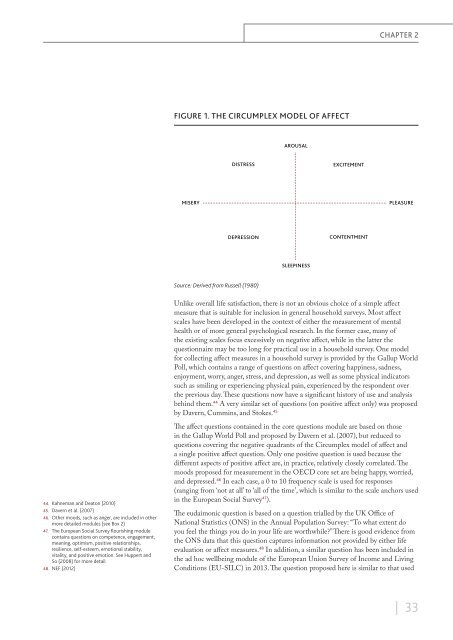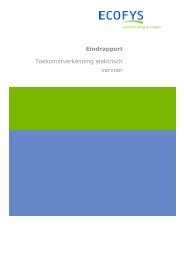commission-on-wellbeing-and-policy-report---march-2014-pdf
commission-on-wellbeing-and-policy-report---march-2014-pdf
commission-on-wellbeing-and-policy-report---march-2014-pdf
Create successful ePaper yourself
Turn your PDF publications into a flip-book with our unique Google optimized e-Paper software.
CHAPTER 2<br />
FIGURE 1. THE CIRCUMPLEX MODEL OF AFFECT<br />
AROUSAL<br />
DISTRESS<br />
EXCITEMENT<br />
MISERY<br />
PLEASURE<br />
DEPRESSION<br />
CONTENTMENT<br />
SLEEPINESS<br />
Source: Derived from Russell (1980)<br />
Unlike overall life satisfacti<strong>on</strong>, there is not an obvious choice of a simple affect<br />
measure that is suitable for inclusi<strong>on</strong> in general household surveys. Most affect<br />
scales have been developed in the c<strong>on</strong>text of either the measurement of mental<br />
health or of more general psychological research. In the former case, many of<br />
the existing scales focus excessively <strong>on</strong> negative affect, while in the latter the<br />
questi<strong>on</strong>naire may be too l<strong>on</strong>g for practical use in a household survey. One model<br />
for collecting affect measures in a household survey is provided by the Gallup World<br />
Poll, which c<strong>on</strong>tains a range of questi<strong>on</strong>s <strong>on</strong> affect covering happiness, sadness,<br />
enjoyment, worry, anger, stress, <strong>and</strong> depressi<strong>on</strong>, as well as some physical indicators<br />
such as smiling or experiencing physical pain, experienced by the resp<strong>on</strong>dent over<br />
the previous day. These questi<strong>on</strong>s now have a significant history of use <strong>and</strong> analysis<br />
behind them. 44 A very similar set of questi<strong>on</strong>s (<strong>on</strong> positive affect <strong>on</strong>ly) was proposed<br />
by Davern, Cummins, <strong>and</strong> Stokes. 45<br />
44. Kahneman <strong>and</strong> Deat<strong>on</strong> (2010)<br />
45. Davern et al. (2007)<br />
46. Other moods, such as anger, are included in other<br />
more detailed modules (see Box 2)<br />
47. The European Social Survey flourishing module<br />
c<strong>on</strong>tains questi<strong>on</strong>s <strong>on</strong> competence, engagement,<br />
meaning, optimism, positive relati<strong>on</strong>ships,<br />
resilience, self-esteem, emoti<strong>on</strong>al stability,<br />
vitality, <strong>and</strong> positive emoti<strong>on</strong>. See Huppert <strong>and</strong><br />
So (2008) for more detail<br />
48. NEF (2012)<br />
The affect questi<strong>on</strong>s c<strong>on</strong>tained in the core questi<strong>on</strong>s module are based <strong>on</strong> those<br />
in the Gallup World Poll <strong>and</strong> proposed by Davern et al. (2007), but reduced to<br />
questi<strong>on</strong>s covering the negative quadrants of the Circumplex model of affect <strong>and</strong><br />
a single positive affect questi<strong>on</strong>. Only <strong>on</strong>e positive questi<strong>on</strong> is used because the<br />
different aspects of positive affect are, in practice, relatively closely correlated. The<br />
moods proposed for measurement in the OECD core set are being happy, worried,<br />
<strong>and</strong> depressed. 46 In each case, a 0 to 10 frequency scale is used for resp<strong>on</strong>ses<br />
(ranging from ‘not at all’ to ‘all of the time’, which is similar to the scale anchors used<br />
in the European Social Survey 47 ).<br />
The eudaim<strong>on</strong>ic questi<strong>on</strong> is based <strong>on</strong> a questi<strong>on</strong> trialled by the UK Office of<br />
Nati<strong>on</strong>al Statistics (ONS) in the Annual Populati<strong>on</strong> Survey: “To what extent do<br />
you feel the things you do in your life are worthwhile” There is good evidence from<br />
the ONS data that this questi<strong>on</strong> captures informati<strong>on</strong> not provided by either life<br />
evaluati<strong>on</strong> or affect measures. 48 In additi<strong>on</strong>, a similar questi<strong>on</strong> has been included in<br />
the ad hoc <strong>wellbeing</strong> module of the European Uni<strong>on</strong> Survey of Income <strong>and</strong> Living<br />
C<strong>on</strong>diti<strong>on</strong>s (EU-SILC) in 2013. The questi<strong>on</strong> proposed here is similar to that used<br />
| 33



